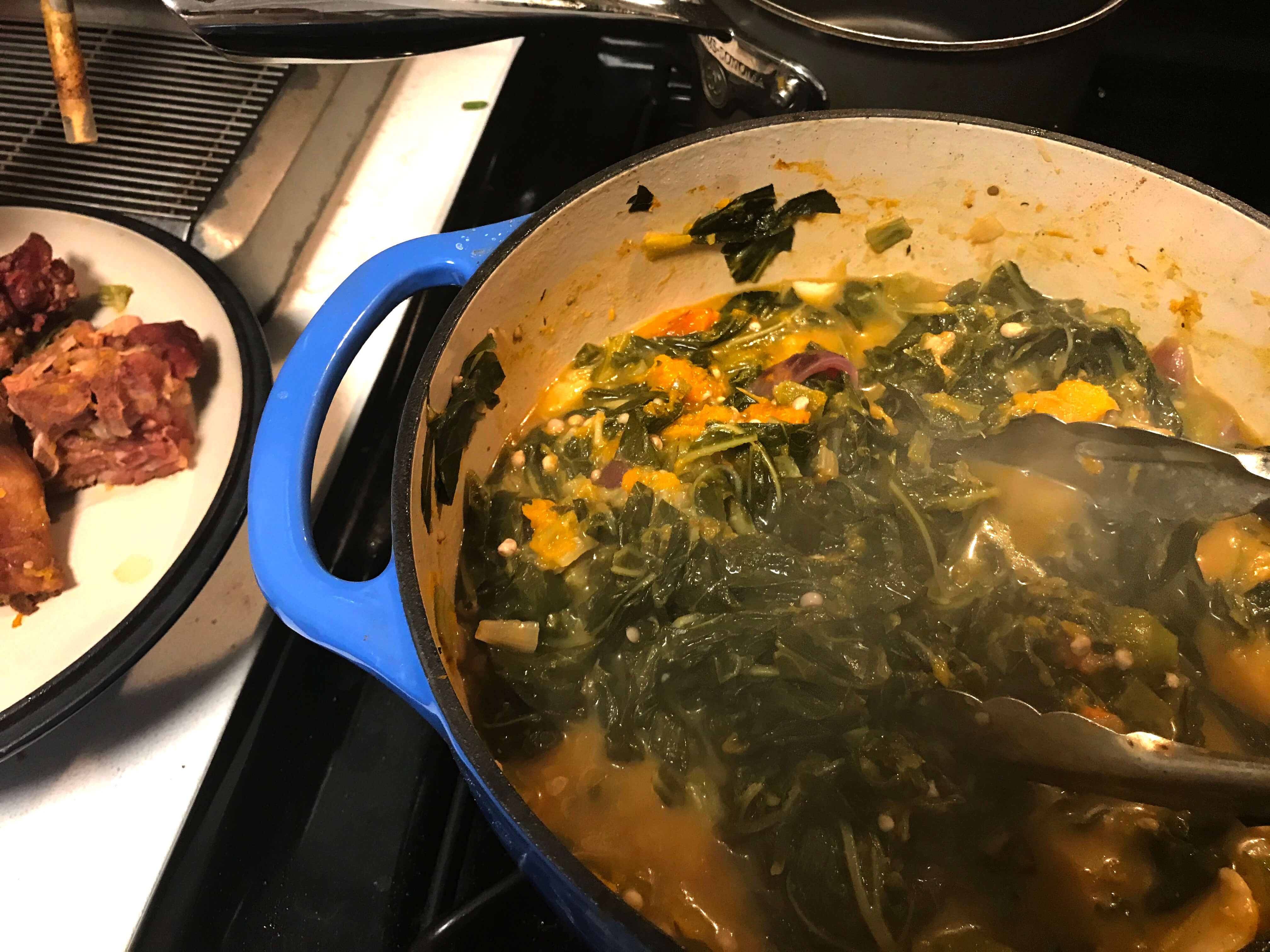

For me, callaloo stores memories of ancestral survival, Sundays past, and the comfort my mother gave us through food.
The crisis didn’t get real for me until the schools closed. That long-awaited decision centered the reality of a global pandemic in New York City, where I live: Here, schools are a haven for many children who live in transitional, temporary homes, particularly in the under-resourced Brooklyn district my son’s school is in. The mayor, citing the importance of school food, delayed closing schools out of fear these children would lose a central source of nourishment. His decision to finally do so, while responsible and necessary, was a sign of worse things to come—and that’s why I wanted to make callaloo.
Rae Gomes
A pot of ingredients to make callaloo, an Afro-Caribbean dish.
I grew up in Trinidad, West Indies, and my mother cooked callaloo almost every Sunday: an Afro-Caribbean dish made with dasheen bush (the leaves from the taro root), okra, and pumpkin. The soupy sauce is spooned over rice, macaroni pie, or potato salad, with a green salad, and my mom would make baked chicken doused in barbecue sauce along with the carbs. In the U.S. I make it with collard greens, frozen chopped okra, and butternut squash. It’s one of the few dishes my American-born son cherishes—and I cherish it too, though not just for the taste. The tradition of callaloo on Sunday is unshakeable for many Trinidadians, no matter what good or bad things are happening outside their doors. Enslaved Africans brought the foundation of the recipe to the colonies, and its various forms are a mark of cultural identity in other Caribbean islands. For me, it’s become a symbol of a certain kind of daily perseverance and continuity of life.
Mayor DeBlasio announced that schools would be closed on Sunday, March 15. The following Monday morning at 8 a.m., I woke my tired son up to take a taxi to the Park Slope Food Co-op, where a line snaked up the block. I needed the ingredients for callaloo: the freshest collard greens, a bag of frozen okra, and a beautiful, firm butternut squash. The sauce would last the week, fueling us while I continued my work for Red Hook Initiative, a youth-centered nonprofit, from home—strategizing coronavirus messaging, helping to get the word out about sources of food and medical support in a neighborhood already cut off from the services many people take for granted.
The tradition of callaloo on Sunday is unshakeable for many Trinidadians, no matter what good or bad things are happening outside their doors.
I didn’t get to make the callaloo until the weekend, but that almost felt right. I ended up doing so on Sunday, the traditional day it’s enjoyed by families across Trinidad. I roasted the butternut squash (my mom would have used a different variety that’s hard to get here, but less flavorful than butternut). I used two frozen pimentos, the only ones left from a full bag she brought me from Trinidad when she came for Christmas. And I boiled the meat—a step I usually skip, except I realized the tasty liquid that results makes up for a lack of stock, which I was out of. The greens, squash, and okra would steam in that liquid and be joined by some thyme, onion, and garlic to create a rich, savory-smelling green goo.
Rae Gomes
Callaloo is typically made with dasheen bush (leaves from the taro root), okra, and pumpkin. In the U.S., Gomes makes it with collard greens, frozen chopped okra, and butternut squash. The soupy sauce is served with baked chicken and greens.
When I was around my son’s age, an extremist group in Trinidad took over the government and shot then-Prime Minister A.N.R. Robinson. The whole country had a curfew and we were prohibited from going outside to play. I remember the fear in my mother’s eyes, a fear I only saw repeated the afternoon she furiously searched for tape to tape down the windows when a hurricane warning surged through. Disaster planning all meshed into one all encompassing feeling and vision. Fear and tape. During the coup, every sound was maybe a gunshot, and my cousin was all too excited to confirm it so. Yet there was still callaloo on Sundays.
In our Brooklyn neighborhood, gunshots are replaced by sirens—but the same visions of death come in the aftermath of the sounds. I try to keep a positive disposition to protect us from the fear of not knowing, my own way of applying tape all around our home. I spoon callaloo over rice, to keep us healthy. I freeze a lot of it in case I get sick. I want to always have some on hand, a key part of our disaster preparedness plan: the dish that stores memories of ancestral survival, Sundays past, and the comfort my mother gave us through food.
Grist, an award-winning, nonprofit media organization dedicated to highlighting climate solutions and uncovering environmental injustices,…
Every year, California dairy farms emit hundreds of thousands of tons of the potent greenhouse…
Highway 7 runs north-south through western Washington, carving its way through a landscape sparsely dotted…
One of the greatest pleasures I had as a child growing up in the Chicago…
Undocumented immigrants experience food insecurity at much higher rates than other populations, yet they are…
Writer Charlotte Druckman and editor Rebecca Flint Marx are both Jewish journalists living in New…